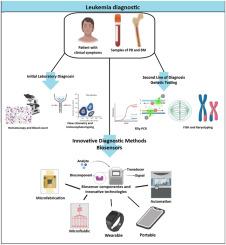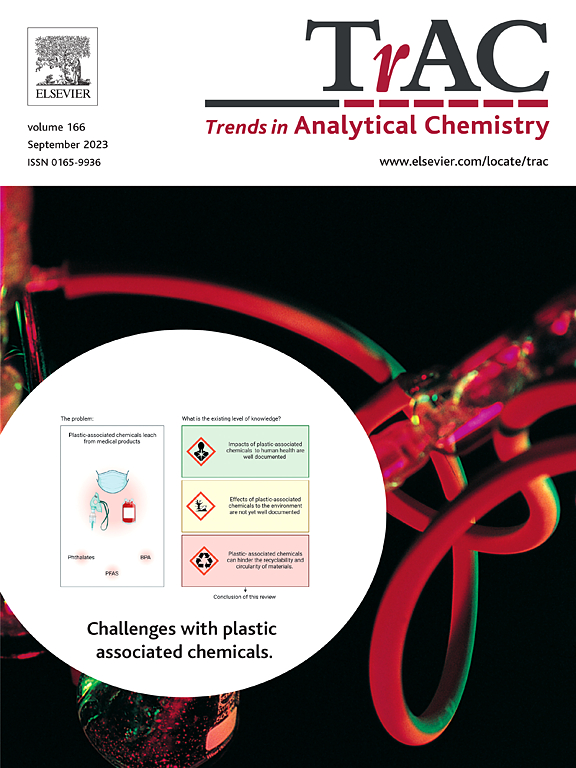白血病诊断生物传感器的最新发展趋势:临床应用的电化学和光学方法综述
IF 11.8
1区 化学
Q1 CHEMISTRY, ANALYTICAL
引用次数: 0
摘要
白血病是一种表现各异的造血肿瘤。为了对患者进行初步诊断和风险分层,有必要同时进行多项检查,以确定预后和适当的治疗。初步检查包括通过全血细胞计数和流式细胞术与免疫分型对白血病细胞进行评估和检测。然而,要进行决定性的治疗分类,核型分析、荧光原位杂交和 RT-PCR(转录酶反应与聚合酶链反应相结合)等检测是必不可少的。有鉴于此,人们开发了各种生物传感器,以解决其中的一些局限性。这是因为这些装置的设计成本低、操作简单、可快速准确地进行检测。因此,本综述将讨论白血病生物传感器所采用的不同策略、技术和工具,以及生物设备真正应用于常规诊断所面临的主要挑战。在这方面,应用于白血病的生物传感器可细分为细胞和癌基因检测。本文讨论了用作传导方法的电化学和光学技术,以及纳米结构、生物标志物、挑战和这些工具的前景。此外,还讨论了感兴趣的一般生物标记物和涉及不同生物分子组合的创新战略。所遇到的一些挑战包括在与片上实验室技术兼容的微型系统中应用生物传感器,以及能够处理与白血病病例中存在的分子异质性有关的复杂标记物的设备。本文章由计算机程序翻译,如有差异,请以英文原文为准。

Recent trends in biosensors for leukemia diagnosis: A critical overview of electrochemical and optical approaches for clinical applicability
Leukemia is a hematopoietic cancer with heterogeneous manifestations. For the initial diagnosis and risk stratification of patients, it is necessary to perform several tests together to delineate the prognosis and appropriate therapy. Initial tests involve the evaluation and detection of leukemic cells with complete blood count and flow cytometry with immunophenotyping. However, for decisive therapy classification, tests such as karyotyping, fluorescent in situ hybridization, and RT-PCR (transcriptase reaction combined with polymerase chain reaction) are indispensable. In view of this, various biosensors have been developed with the aim of addressing some of these limitations. This is because these devices are designed for low-cost, simple, and quickly interpretable detection with accuracy. Thus, this review discusses different strategies, techniques, and tools used in leukemia biosensors as well as the main challenges for the real applicability of bio-devices in diagnostic routines. In this regard, biosensors applied to leukemia have been subdivided into the detection of cells and oncogenes. He electrochemical and optical techniques used as transduction methods are discussed, along with nanostructuring, biomarkers, challenges, and perspectives of these tools. Additionally, general biomarkers of interest and innovative strategies involving the combination of different biomolecules are also discussed. Some challenges encountered include the application of biosensors in miniaturized systems compatible with lab-on-chip technologies, as well as devices capable of addressing the complexity of markers in relation to the molecular heterogeneity present in leukemia cases.
求助全文
通过发布文献求助,成功后即可免费获取论文全文。
去求助
来源期刊

Trends in Analytical Chemistry
化学-分析化学
CiteScore
20.00
自引率
4.60%
发文量
257
审稿时长
3.4 months
期刊介绍:
TrAC publishes succinct and critical overviews of recent advancements in analytical chemistry, designed to assist analytical chemists and other users of analytical techniques. These reviews offer excellent, up-to-date, and timely coverage of various topics within analytical chemistry. Encompassing areas such as analytical instrumentation, biomedical analysis, biomolecular analysis, biosensors, chemical analysis, chemometrics, clinical chemistry, drug discovery, environmental analysis and monitoring, food analysis, forensic science, laboratory automation, materials science, metabolomics, pesticide-residue analysis, pharmaceutical analysis, proteomics, surface science, and water analysis and monitoring, these critical reviews provide comprehensive insights for practitioners in the field.
 求助内容:
求助内容: 应助结果提醒方式:
应助结果提醒方式:


